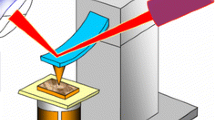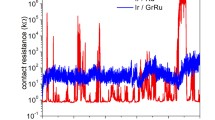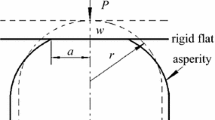Abstract
As the reliability of electrical microcontacts has proved to be the main limitation to a fast-growing production of ultraminiaturized switches, a thorough understanding of their failure mechanisms is an all-important purpose. This paper aims at showing that conducting-probe Atomic Force Microscopy (cp-AFM) is an adequate tool to actuate and study electrical contacts. By choosing relevant cantilevers and operating mode of the cp-AFM, dimensions, gap and force level representative of existing microelectromechanical switches (MEMS switches) are obtained. With two examples, the advantages of using a cp-AFM in force mode for studying physical phenomena at very low scale are highlighted. The reported investigations concern material transfer between contact parts and contact bounces. Those two undesirable phenomena induce surface damages and impinge reliability of MEMS switches. In both cases an explanatory scenario of phenomena occurring at nanoscale is proposed and preventive recommendations for improving the lifetime of such devices are suggested.









Similar content being viewed by others
References
Toler, B. F., Coutu, R. A., & McBride, J. W. (2013). A review of micro-contact physics for microelectromechanical systems (MEMS) metal contact switches. Journal of Micromechanics and Microengineering, 23, 103001.
Slade, P. G. (2009–2013). Electrical contacts: Principles and applications (2nd ed.). Boca Raton: CRC Press. ISBN: 9781439881309.
Edelmann, T. A., & Coutu, R. A. (2010). Microswitch lifecycle test fixture for simultaneously measuring contact resistance (Rc) and contact force (Fc) in controlled ambient environments. In IEEE Holm conference on electrical contacts (pp. 3009–3016). doi:10.1109/HOLM.2010.5619527.
Vincent, M., Chiesi, L., Rousset, P., Lapiere, C., Poulain, C., Carbone, L., Houzé, F., & Delamare, J. (2009). An original apparatus for endurance testing of MEMS electrical contact materials. In IEEE Holm conference on electrical contacts (pp. 288–292). doi:10.1109/HOLM.2009.5284386.
Broué, A., Dhennin, J., Courtade, F., Charvet, P., Pons, P., Lafontan, X., & Plana, R. (2010). Thermal and topological characterization of Au, Ru and Au/Ru based MEMS contacts using nanoindenter. In IEEE MEMS conference (pp. 544–547).
Arrazat, B., Duvivier, P.-Y., Mandrillon, V., & Inal, K. (2011). Discrete analysis of gold surface asperities deformation under spherical nano-indentation towards electrical contact resistance calculation. In IEEE Holm conference on electrical contacts. doi:10.1109/HOLM.2011.6034798.
Beale, J. P., & Pease, R. F. W. (1992). Apparatus for studying ultrasmall contacts. In IEEE Holm conference on electrical contacts (pp. 45–49). doi:10.1109/HOLM.1992.246935.
Yang, Z., et al. (2007). A new test facility for efficient evaluation of MEMS contact materials. Journal of Micromechanics and Microengineering, 17, 1788–1795.
Yang, Z., Lichtenwalner, D., Morris, A., Krim, J., & Kingon, A. I. (2010). Contact degradation in hot/cold operation of direct contact micro-switches. Journal of Micromechanics and Microengineering, 20, 105028.
Tringe, J. W., Uhlman, T. A., Oliver, A. C., & Houston, J. E. (2003). A single asperity study of Au/Au electrical contacts. Journal of Applied Physics, 93(8), 4661–4669.
Vincent, M., Rowe, S. W., Poulain, C., Mariolle, D., Chiesi, L., Houzé, F., et al. (2010). Field emission and material transfer in microswitches electrical contacts. Applied Physics Letters, 97, 263503.
Peschot, A., Poulain, C., Souchon, F., Bonifaci, N., & Lesaint, O. (2012). Contact degradation due to material transfer in MEM Switches. Microelectronics Reliability, 52, 2261–2266.
Chowdhury, F. K., Pourzand, H., & Tabib-Azar, M. (2013). Investigation of contact resistance evolution of Ir, Pt, W, Ni, Cr, Ti, Cu and Al, over repeated hot-contact switching for NEMS switches. In IEEE MEMS conference (pp. 445–448).
Chen, L., Guo, Z. J., Joshi, N., Eid, H., Adams, G. G., & McGruer, N. E. (2012). An improved SPM-based contact tester for the study of microcontacts. Journal of Micromechanics and Microengineering, 22, 045017.
Hennessy, R. P., Basu, A., Adams, G. G., & McGruer, N. E. (2013). Hot-switched lifetime and damage characteristics of MEMS switch contacts. Journal of Micromechanics and Microengineering, 23, 055003.
Basu, A., Hennessy, R. P., Adams, G. G., & McGruer, N. E. (2014). Hot-switching damage mechanisms in MEMS contacts—Evidence and understanding. Journal of Micromechanics and Microengineering, 24, 105004.
Streller, F., Wabiszewski, G. E., & Carpick, R. W. (2015). Next-generation nanoelectromechanical switch contact materials: A low-power mechanical alternative to fully electronic field-effect transistors. IEEE Nanotechnology Magazine, 9, 18–24.
Sumali, H., Massad, J. E., Czaplewski, D. A., & Dyck, C. W. (2007). Waveform design for pulse-and-hold electrostatic actuation in MEMS. Sensors and Actuators A, 134, 213–220.
LaRose, R. P., & Murphy, K. D. (2010). Impact dynamics of MEMS switches. Nonlinear Dynamics, 60, 327–339.
Fruehling, A., Yang, W., & Peroulis, D. (2012). Cyclic evolution of bouncing for contacts in commercial RF MEMS switches. In IEEE MEMS conference (pp. 688–691).
Peschot, A., Poulain, C., Bonifaci, N., & Lesaint, O. (2012). Contact bounce phenomena in a MEM Switch. In IEEE Holm conference on electrical contacts. doi:10.1109/HOLM.2012.6336560.
Butt, H. S., Cappella, B., & Kappl, M. (2005). Force measurements with the atomic force microscope: Technique, interpretation and applications. Surface Science Reports, 59, 1–52.
Rezvanian, O., Zikry, M. A., Brown, C., & Krim, J. (2007). Surface roughness, asperity contact and gold RF MEMS switch behavior. Journal of Micromechanics and Microengineering, 17, 2006–2015.
Yang, Z., Hoffmann, S., Lichtenwalner, D. J., Krim, J., & Kingon, A. I. (2011). Resolution of the transfer direction of fiel-evaporated gold atoms for nanofabrication and microelectromechanical system applications. Applied Physics Letters, 98, 044102.
Peschot, A., Bonifaci, N., Lesaint, O., Valadares, C., & Poulain, C. (2014). Deviations from the Paschen’s law at short gap distances from 100 nm to 10 µm in air and nitrogen. Applied Physics Letters, 105, 123109.
Meng, G., Cheng, Y., Wu, K., & Chen, L. (2014). Electrical characteristics of nanometer gaps in vacuum under direct voltage. IEEE Transactions on Dielectrics and Electrical Insulation, 21(4), 1950–1956.
Peschot, A., Poulain, C., Sibuet, H., Souchon, F., Bonifaci, N., & Lesaint, O. (2013). Spectroscopic analysis of material transfer phenomena in MEMS switches. In IEEE IRPS (p. ME.3).
Acknowledgments
The authors wish to acknowledge the assistance and support of the Délégation Générale de l’Armement (DGA) for supporting this research.
Author information
Authors and Affiliations
Corresponding author
Additional information
This article is part of the Topical Collection on Green Solutions for Body Area Networks.
Rights and permissions
About this article
Cite this article
Peschot, A., Vincent, M., Poulain, C. et al. Conducting Probe Atomic Force Microscope as a Relevant Tool for Studying Some Phenomena in MEMS Switches. Sens Imaging 16, 21 (2015). https://doi.org/10.1007/s11220-015-0124-1
Received:
Revised:
Published:
DOI: https://doi.org/10.1007/s11220-015-0124-1




